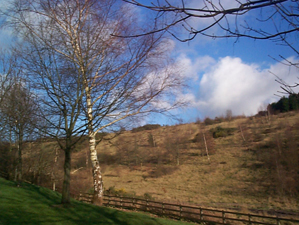Historic Landscape
Characterisation
Merthyr Tydfil
048 Cwm Blacks
HLCA 48 Cwm Blacks Reclaimed 19th century coal workings;
urban green space; modern transport corridor.
Click here for a
character area map
Summary
A reclaimed area of intensive 19th century coal workings associated with the Plymouth Iron Works. The area currently functions as a transport corridor for the A4060(T).
Historical background
The historic landscape area of Cwm Blacks comprises a reclaimed area of intensive late 18th/early 19th century ironstone and coal workings associated with Anthony Hill and the Plymouth Iron Company.
Cartographic evidence of 1813 indicated that Iron Mines were situated just to the north within the Cwm Blacks/Pencoedcae area. By 1826, a network of tramroads and inclines, including the main Clyn Mil/Coedcae Incline System, had been established throughout the area connecting the Plymouth Iron Works with various workings both within and beyond the area; these included ironstone levels and patch workings within Cwm Blacks. The area was part of the Clyn-Mil holding of the estate of Robert Henry Clive, leased to Anthony Hill in 1850.
The area had been intensively worked by the publication of the 1875 6-inch OS map, which indicated ironstone and coal levels, at least one shaft, various small 'lobed' and linear tips, and reservoirs and leats arranged along the eastern bank of Nant Cwm Blacks. The Clyn Mil Incline and various tramroads connecting the ironstone/coal workings of the area and the Plymouth Ironworks were also detailed in 1875; numerous other tracks indicated, might suggest that a once far more extensive network of tramways and haul roads previously served the area. The cartographic evidence indicated that mining activity had all but ended in the area between 1875 and 1898, probably with the closure of the Plymouth Ironworks in 1880. The area was subsequently subject to reclamation and road building during the last quarter of the 20th century.
